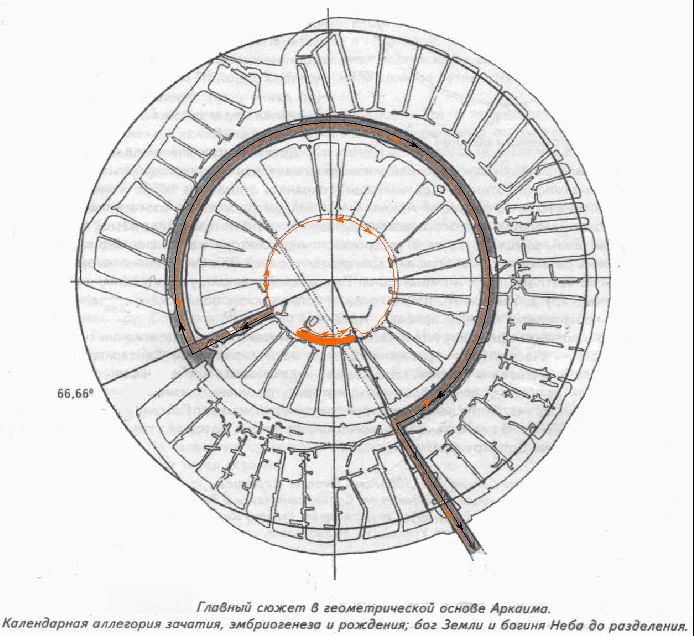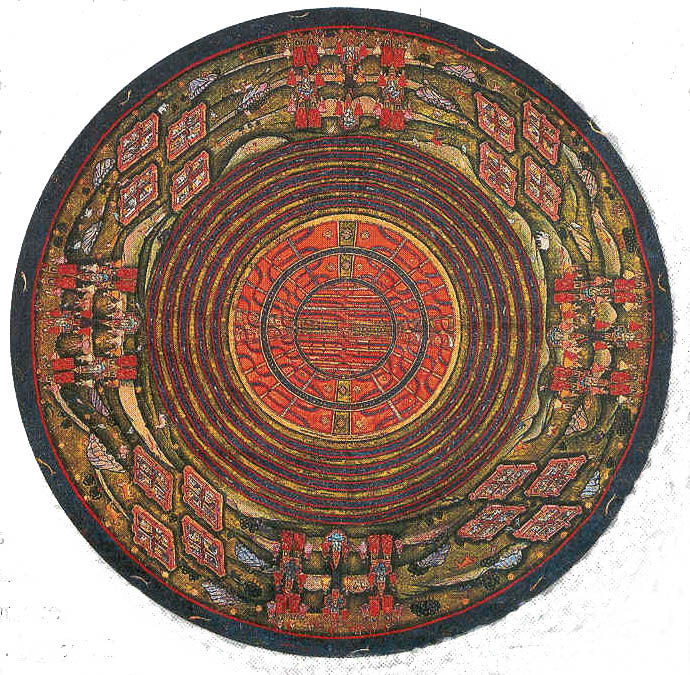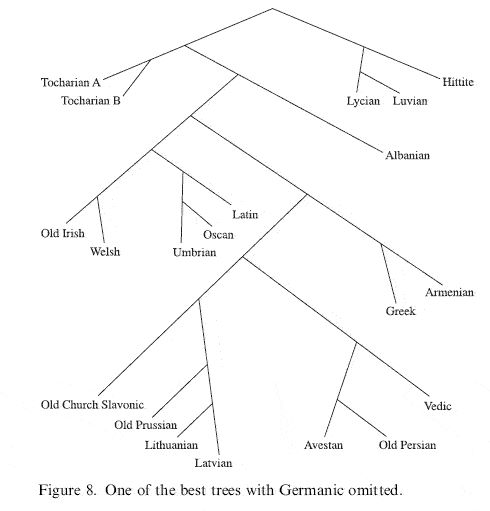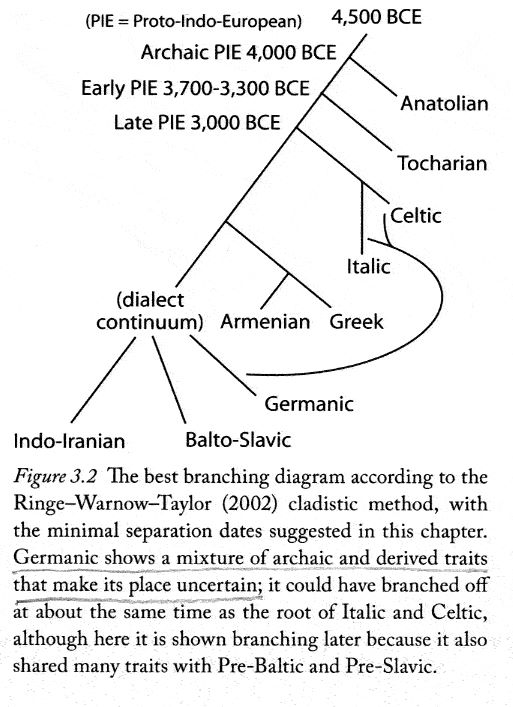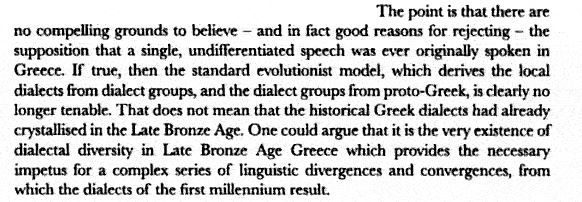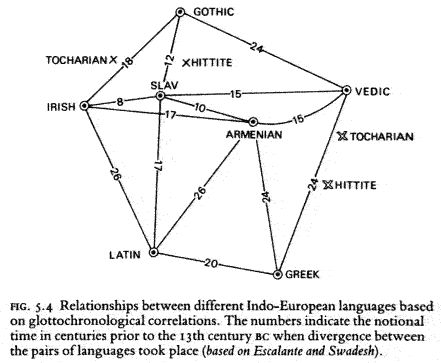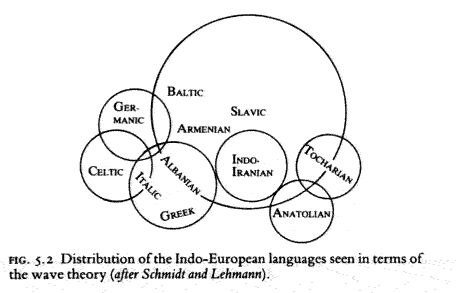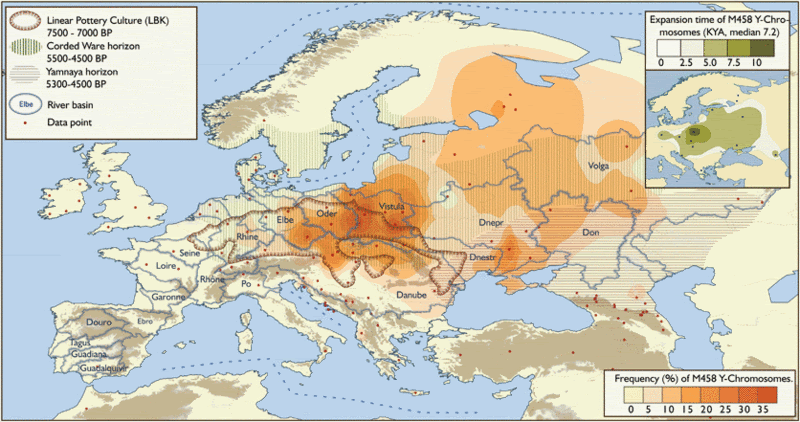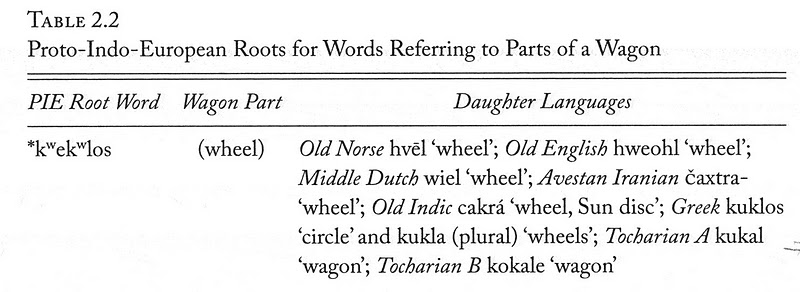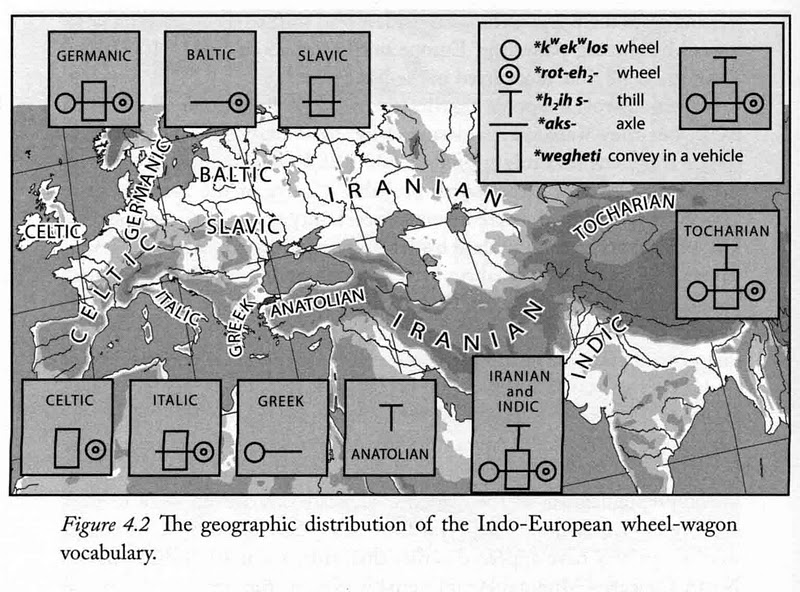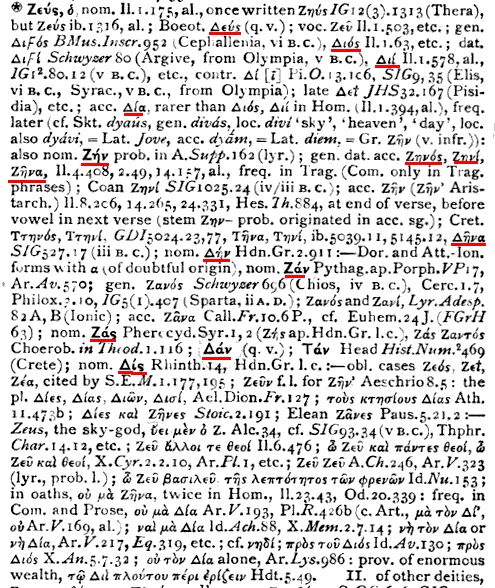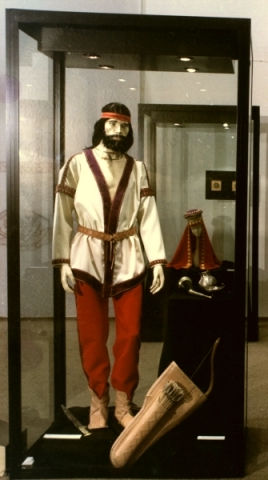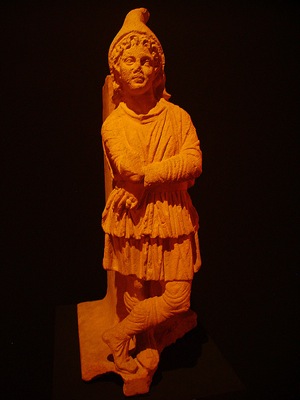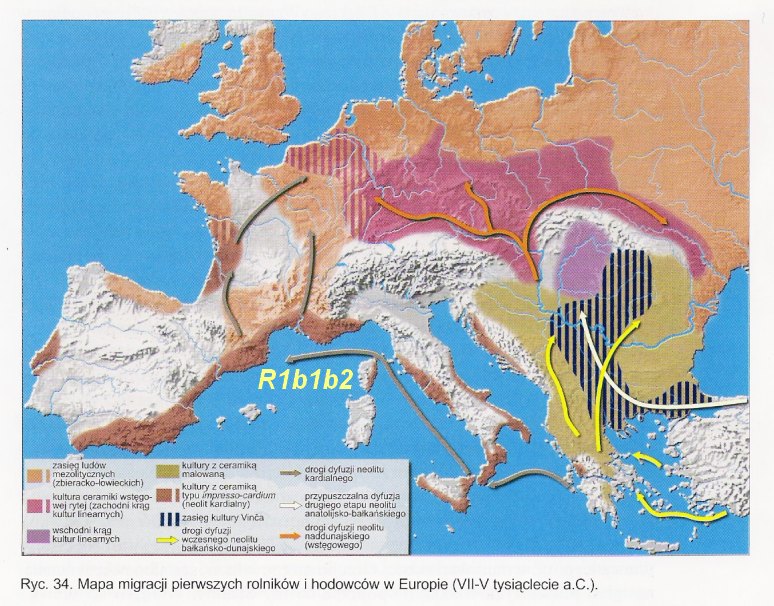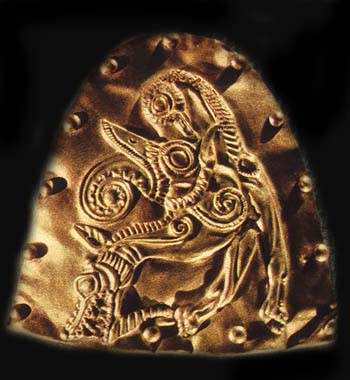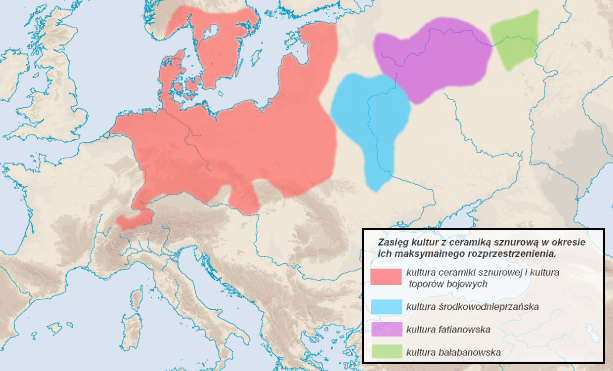© translated by Katarzyna Goliszek
Even a few months ago rasing the question which is in the headline would have brought about numerous protests, and he who had asked it, would have been called a nationalistic idiot. A lot has changed recently owing to genetics. The world can be said to have turned upside down. More and more proofs indicate that indeed Pre-Slavic peoples and Pre-Indo-Europeans mean the same, and for sure Slavs-Scyths can be regarded as one of such peoples. And just think that when I was beginning to write Slavic Mythology, scientific experts could not believe that I was referring to the thesis of the origin of the Slavs and the Slavic ancient times from the areas of the Vistula River and not of their sudden birth from nonentity in the VI th century AD.
I quote here an important extract of a long and meaningful online discussion on the latest current genetic and linguistic discoveries as well as combining these discoveries and theories with archaeological cultures. The discussion is on http://forum.histmag.org/index.php?topic=8836.360 where you can trace its whole course. Different arguments are being used in the discussion but undoubtedly we are getting closer to the surprising truth about ourselves. Therefore, I decided to present an excerpt of this truth here. The discussion has been going on and the excerpt comes from 25th February 2010.
The main subject in the geometric basis of Arkaim. The calendar allegory of the beginning, embriogenesis and being born; The God of the Earth and the Goddess of Heaven before division.
I refer those of you who are deeply interested in the subject to that website (the discussion is really meticulous and comes back dozens of times to the same unresolved clue). Here, I present only an interesting passage that I agree with to a large extent and which is only the proof of the mythological events of the Sis Kingdom that are written about in Księga Tura (the Book of Aurochs) and Księga Ruty (the Book of Rue).
”
Searching for answers to the questions about the ethnogenesis of the Slavs, we need to take an interest in the issue of the Indo European community – who the Pre-Indo-Europeans (PIE) were and where they lived.
So far, this problem has been the subject of speculations and countless disputes. Now, thanks to the new and crucial discoveries of geneticists, linguists, anthropologists and archaeologists we can attempt to get new, more accurate answers.
I am interested in what genes the PIE had, what they looked like, what language, more or less, they spoke and where their homeland was. First and foremost, however, I would like to find answers to the following questions: what linked the PIE with the Pre-Slavs, what did the process of forming out of the Pre-Slavic group from the PIE community look like and did the process take place at all, and if so when and where was it?
Old theories of the PIE language said that there had once been a community of speakers of the uniform PIE language who lived in the same territory of the peoples. The community then broke up into numerous tribes speaking such languages as: Pre-Celtic, Pre-Germanic, Pre-Greek, Pre-Armenian, Pre-Slavic, Pre-Indo-Iranian, etc. which then wandered from their common place and took new territories giving rise to the contemporary Indo-European languages. Today we know that such a scenario could not have happened simply because genetics excludes that.
What is then the true history of the PIE community and the PIE language?
1.Politics distorted the knowledge of the PIE language
Discussing the theory of the PIE community must be started with criticism and indication where the sources of errors are.
In 1857, an outstanding Polish orientalist working at the University of Berlin Ignacy Pietraszewski published his work about the research on the holy texts of Zarathustra. In his work he proved a close relation of the Avestan language with the Polish language. This discovery was significant because, in reality, Slavic languages are more similar to the languages of ancient Iran or India than any other European languages.
What reward did the Polish researcher get for such a remarkable achievement? Did he get a promotion? Did he become famous? No, none of the things. He was deprived of his chair and he was expelled from the university. He had no choice but publish his books with his private money and he did it because he was a patriot.
Thanks to his pioneering work we now know how close linguistic relation we have to peoples creating the great civilisations of Asia, and thanks to the new discoveries in genetics we also know that the peoples who invaded Iran and India in the Bronze and Iron ages giving rise to those civilisations came from Central and Eastern Europe and were very similar to us in terms of genetics and phenotype. Genetics and linguistics lead to similar conclusions.
Germans ignored the proximity of the Slavic languages to the Indo-Iranian languages trying to highlight their alleged relationships. They made up the theory of so called Indo-Germanic languages and persuaded the world that some Indo-Germans had travelled to India. Today we know that it is complete nonsense as in India, among the Brahmin caste being the descendants of the Indo-European Aryans, even a single carrier of Germanic and Celtic haplotypes belonging to haplogroup R1b and I1 was not found. There are frequent R1a haplogroup (80%) and numerous haplotypes that are identical to the ones that we meet among the Slavs. The linguistic relationships of Germanic languages with Indo-Iranian languages are also very distant and often just seeming, whereas the Slavic languages are close to the Indo-Iranian languages.
You can clearly see that since the Indo-European studies came into being in the 19th century they have been distorted by the German nationalism and lots of mistakes have been till today.
2.Germanic Languages – an example of mixed languages
Germanic languages pose many problems for linguists. It is impossible to classify them. A group of American scientists: D. Ringe, T. Warnow, and A. Taylor trying to group Indo-European languages basing on computer analyses found that the Germanic languages show too many anomalies and do not fit into other languages. Their calculations did not give meaningful results. Therefore it was decided to make calculations leaving out the Germanic languages.
The scientists succeeded in doing their experiment and they received a tree demonstrating relationships among the Indo-European languages:
The authors are convinced that thanks to removing the Germanic languages the computer based calculations of the relationships and similarities gave sensible results, and as a consequence of that they received the best possible form of the tree showing the structure and history of the languages:
Quotes and pictures from:
http://www3.isrl.illinois.edu/ ~ junwang4/langev/localcopy/pdf/ringe02IECladistics.pdf
Some linguists followed by American anthropologist David W. Anthony, are trying to interpret this result as shown in the picture below:
From the book by David W. Anthony, “The Horse, The Wheel and Language” p.57
Anthony was writing his book ignoring the data which genetics provides us with. Relying on the analysis of the vocabulary and genetic history of the Germanic peoples it would be most simply said that the Germanic languages are the languages which came into existence by the mixing of the non Indo-European and Celtic languages, with a certain admixture of Slavic languages – the Eupedia portal does it:
Quote
The Germanic branch of Indo-European languages probably inherited more from the R1b cultures, although R1a is likely to have arrived earlier in Scandinavia, during the Corded Ware period. R1a people would have mixed with the pre-Germanic I1 aborigines to create the Nordic Bronze Age (1800-500 BCE). R1b would have reached Scandinavia later as a northward migration from the contemporary Hallstatt culture (1200-500 BCE). The first truly Germanic tongue could have been a blend of Hallstatt Proto-Celtic and the Corded-Ware Proto-Slavic with a few pre-Germanic loan words. The fact that present-day Scandinavia is composed of roughly 40% of I1, 20% of R1a and 40% of R1b reinforces the idea that Germanic ethnicity and language had acquired a tri-hybrid character by the Iron Age.
http://www.eupedia.com/europe/origins_haplogroups_europe.shtml
3.The Armenian language – an example of Indo-Europesation
Although without the Germanic languages we get more clarity and it is easier to see the similarities, structure and history of the languages, it is of little help for us to understand the history of the PIE language due to the following issue that I will present by giving the example of the Armenian language.
Quote
In particular, both Indo-European speaking Armenians and Altaic-speaking Azerbaijanians group with their geographic neighbours in the Caucasus, rather than with their linguistic neighbours (other Indo-European/Altaic-speaking populations), suggesting language replacements involving the Armenian and Azerbaijanian languages. Remarkably, the genetic distance between pairs of populations was significantly correlated with geographic distance, despite the presence of the Caucasus Mountains as a potentially significant barrier to gene flow.
Quotation from:
http://www.familytreedna.com/pdf/alupaper.pdf
Genetic studies show that the population of Armenia speaking the Indo-European language and speaking the language of Altai do not differ genetically from each other and from other neighbouring Caucasian peoples speaking Caucasian languages, so belonging to a completely different language group.
The authors conclude that the language was replaced in the territory of Armenia, i.e . Indo-Europesation of the population took place whereas in the area of Azerbaijan the same genetic Caucasian population was infuenced by Altai languages. .
Therefore, the Armenian language has many specific features not found in other Indo-European languages as this language is the result of yielding to the influences of Caucasian languages which were spoken by the indigenous population of Armenia.
Quote
Armenian corresponds with other Indo-European languages in its structure, but it shares distinctive sounds and features of its grammar with neighboring languages of the Caucasus region.
http://en.wikipedia.org/wiki/Armenian_language
The Armenian language also demonstrates a number of other influences:
Quote
It is clear that Armenian is an Indo-European language, but its development is opaque. In any case, Armenian has many layers of loanwords and shows traces of long language contact with Hurro-Urartian, Greek and Indo-Iranian.
http://en.wikipedia.org/wiki/Proto-Armenian
The formation process of the Armenian language was the mixing of the Indo-European and Caucasian languages and their evolution. There is no reliable evidence that there once existed a Pre-Armenian or Proto-Armenian language which formed out of the PIE community.
4.The Greek language – an example of the convergence of dialects
There are similar problems with the Pre-Greek or Proto-Greek language. J. Hall, a prominent linguist specialising in the history of the Greek language says:
Quotations from: Ethnic Identity in Greek Antiquity By Jonathan M. Hall, p.169
There is no indication that there had ever existed a Pre-Greek or Proto-Greek language isolated from the PIE community, the language that then gave rise to the historic Greek dialects. Hall denies this. Everything indicates that diverse Indo-European tribes moved to Greece and mingled with the local non Indo-European population which resulted in forming of local dilects, from which then formed out main dilects through complex processes of convergence and divergence and, as a result, the Greek language was shaped.
In terms of genetics the Greek population is similar to the neighbouring populations and significantly differs from the population of central and eastern Europe, from where most probably came Indo-European tribes who invaded Greece in the Bronze Age. In the case of Greece, as in the case of Armenia, replacement of the language and Indo-Europesation of the population took place. It happened, however, in the complex process of evolution, not just through simple replacement of the local languages with a hypothetical Pre-Greek or Proto-Greek language. Most probably such language had never existed.
5.Critics of the PIE language hypothesis
For the reasons given above as well as for other various reasons, many prominent linguists totally reject the PIE language hypothesis. One of them is N.S Trubetskoy:
Quote
“There is Therefore, no compelling reason for the assumption of a homogeneous Indo-European protolanguage from Which the individual branches of Indo-European descended. Equally plausible is it That the ancestors of the branches of the Indo-European originally were dissimilar but that over time, through continuous contact, mutual influence, and loan traffic, they moved significantly closer to each other, without becoming identical (Trubetskoy 2001, Mr. 88). “
Quote
“Thus a language family can be the product of divergence, convergence or a combination of the two (with emphasis on either). There are virtually no criteria that would indicate unambiguously to which of the two modes of development a family owes its existence. When we are dealing with languages so closely related that almost all the elements of vocabulary and morphology of each are present in all or most of the other members (allowing for sound correspondences), it is more natural to assume convergence than divergence (Trubetskoy 2001, p. 89).”
Trubetzkoy, N. S. (2001), “Studies in General Linguistics and Language Structure,” Anatoly Liberman (Ed.), translated by Marvin Taylor and Anatoly Liberman, Durham and London: Duke University Press.
Also Jean-Paul Demoule rejects the hypothesis of the PIE community. He explicitly states that no scientific fact supports the hypothesis that a population speaking the PIE language had ever existed.
Briefly speaking, the hypotheses of the PIE language and the PIE community are not widely accepted. Many scientists contradict them to a larger or smaller extent.
I think that genetics supports the views of the opponents of these hypotheses to some extent. What is the point of reconstruction of the PIE language basing on Germanic, Celtic and Greek languages – which has been done so far – since it is known that the Germanic, Celtic and Greek peoples have not got much in common in terms of genetic aspects with the peoples who co-created the Slavic, Indo-Iranian and Baltic languages and that is why they could never create a community with them, i.e. they could never live in the same territory and speak a uniform language. There were not pre-languages originating like branches from one trunk, i.e. from the PIE language. These branches were created as a process of a variety of influences, intermingling and evolution. There is no doubt that since the beginning, the theory of the PIE language and the hypothesis of the PIE community have been developing with the involvement of politics and nationalisms which warped it. The biggest mistake was undervaluing of the Slavic languages and overvaluing of the Germanic and Celtic languages, which genetic research clearly shows. It is high time we looked at this issue again.
…
The origin of the Indo-European languages according to the Y-DNA genealogy
The Y-DNA genealogy and the Indo-European languages
Haplogroup R1/M173
Pre-Indo-Europeans
| Satem languages | Kentum languages | |
| R1a/L62 | R1b/M343 | |
| R1a1/SRY 10831.2 | R1b1/P25-Hittites | |
| R1b1b/P297 | ||
| R1a1a/M17Pre-Slavs
|
I1/M253+I2b/M223pre-Indo-EuropeanProto-Germans Indo-Europenised
Pre-Germanic Peoples
|
R1b1b2/M269 R1b1b1/M73Pre-Celtc Tocharians |
| Indo-Iranian Slavs Balts Aryans | Germanic peoples | Germanised Celts Romanised Celts Celts |
| Satem languages | Kentum languages | |
| The ”Indo-Europeans” denomination derives from geographical placement of the large linguistic family in the contemporary times. Pre-Indo-Europeans were the ancient creators of these languages, and also the biological community originating from one ancestor with the gene haplogroup of R1/M173 in Y-DNA. | ||
Elkate, linguists say that they are not able to capture any language phenomena older than 10,000 years. The separation of R1a and R1b took place about 20,000 years ago. It is such a long time ago that we can not know anything about languages in those times.
In my view, we are interested in the history of the R1a1 which we consider to be Slavic and which starts for good from holocen, namely 8000 BC in the north of the Black Sea. Then there was global warming and in the area between the Black Sea and the Baltic cultures began to develop – first pastoral, next agricultural. Here, I would seek our ancestors and the beginnings of Indo-European languages that we know. Previously, there had been a glacier and only small groups of people migrating between Asia and Europe, fighting for survival. We do not know anything about their language, customs and religion. We can only speculate.
As far as this clue is concerned, I sometimes would like to deal with closer and investigate to whom we owe the vocabulary denoting, for example, wagon, wheel (circle), religion, numerical system, diverse concepts which came later to the philosophy of India and Greece, an so on and so forth. These words – common to various Indo-European languages – formed surely much later than the emergence of R1a and R1b.
In many experts’ opinions, the Indo-Europesation of our continent was not a simple process of the isolation of the pre-languages from the PIE community and imposing them on non Indo-European residents of conquered territories. The Pre-Greek language did not come to Greece from the PIE homeland, but rather formed in Greece as a result of lengthy and complex processes of mixing Indo-European and non Indo-European languages, their convergence, etc. Similarly Pre-Armenian, Pre-Germanic, Pre-Indo-Iranian, etc. languages developed.
However, there is a question: did all the modern Indo-European languages come into being by mixing with the non Indo-European languages? And if not, which are they?
Here we have to ask both geneticists and linguists for help.
Currently, the vast majority of experts relate the expansion of IE (Indo-European) languages to haplogroup R1a1. One of the reasons is that only this haplogroup occurs among the caste of Brahmins in India, the descendants of Indo-European Aryans. There are not haplogroup R1b and other European markers there at all.
The highest percentage of R1a1 is among the northern Slavs, especially among the Polish, amounting to 60%. If we consider that 16% of R1b in Poland that occurs mainly in the west are relatively new, we can assume that the percentage of R1a1 in the original Slavic population could even have exceeded 80%. Thus, this population is mixed with the non Indo-European element in the slightest.
Another factor testifying the lack of mixing is the archaic character of the language.
Professor Mańczak writes about this:
Quote
[…] the language that developed in the aboriginal homeland is more archaic than the languages which formed on foreign substrates. In other words, these researchers put forth the postulate that the aboriginal homeland must be looked for in the places where the language is the most archaic. […] the vocabulary of the Polish language has the most etymological references to other Indo-European languages, from which the conclusion is that the Indo-European aboriginal abode should be identified with the Slavs’ aboriginal homeland, namely the basin of the Odra and the Vistula Rivers. In other words, the Slavs are the descendants of this part of the Pre-Indo-European population that remained in the aboriginal homeland while the Balts, Germans, Celts, etc., are the descendants of this part of the Pre-Indo-Europeans that left their aboriginal abode settling in areas inhabited by non Indo-European peoples, and therefore the Baltic, Germanic , Celtic, etc. vocabulary is less archaic than Slavic (Mańczak 1992).
Quotation from: http://www.mimuw.edu.pl/polszczyzna/PTJ/b/b55_123-130a.pdf
Many analyses show the central position of the Slavic languages in relation to other Indo-European languages. The chart below is from the book “Archaeology and language: the puzzle of Indo-European Origins” By Colin Renfrew p.116
Also the wave theory which is competitive towards the tree hypothesis presents an interesting model of the distribution of the IE languages. The wave theory is presented in the chart below:
Chart from the book by Renfrew p.105
The Slavic languages seem to be the source of the wave.
The tree theory which is illustrated in chart above – D. Ringe, T. Warnow, and A.Taylor – has more supporters. It is worth noticing that all the language branches of the tree rose by mixing the IE languages with some other non Indo-European languages.
The exception are only the Slavic languages. Therefore, it is worth considering what should be regarded in the tree as the branches and what as the trunk.
It seems that even after cutting off all the branches the tree will live and grow new ones. Genesis of the Slavic languages is, in fact, independent of the other languages. But what would have happened if the haplogroup R1a1 giving rise to our ancestors had not appeared about 8000 BC in the north of the Black Sea?
I think that many things will become more clear if we show examples of influences and relationships:
…
The theory that I presented in the diagram, called the theory of haplogroup R1, gives justice best to the Indo-European populations; at any rate it does not replace the defeated pangermanism with panslavism (and phenomena like this one already appear on many portals and Internet forums).
The theory of haplogroup R1
is based on the knowledge of the fundamental fact that:
the basic phenomena of culture, especially the language, form and develop and are basically only transmitted within families, clans and tribes.
This in particular concerns primitive, ancient societies that led all their lives within families and tribes being very clearly separated from other similar units – unless kin – linguistically identical.
They were typically patriarchal communities developing along male genealogical lines.
That is why, throughout thousands of years they identified themselves almost wholly with the haplogroups of the Y-DNA genealogy.
Thus, we need to look for answers to the puzzle of rising of the family of Indo-European languages along the lines of Y-DNA genealogy.
Of course, there are exceptions to this rule but they are caused by extraordinary historical events and living conditions. This, for example, relates to the Greeks, Armenians, Scandinavian R1a, Kyrgyz R1a, or Basque or Cameroonian R1b.
As for the Basque language, I suppose that a male dissenter from the R1b1b2 population went into a Caucasian non Indo-European, matriarchal family; he gave parental intitiative to a female and her language, and the contemporary Basques have to cope with it…
Although I do not disregard linguists’ theories, I think it is not worth thinking too much about them. Linguists who have been studying the origins of Indo-European languages so far have been searching for colours in a very dense fog. That is why they have developed so many theories and genealogical patterns which contradict each other.
Now they have the genetic genealogy so they should take advantage of it as soon as possible!
P.S. Did you notice in the book by Sir Anthony the paragraph: “The ancestor of English: The origin of Spread of the Usatovo Dialect” (p.359). What was the major hallmark for the author telling him that the ethnogeny of Germanic peoples / English began in Usatovo? He stated or he is just attempting to assert that the feudal attitide of sovereign-client and using the sword appeared there, especially in relation to the Dnieper population of the Trypillian culture of the C2 phase (proto-Slavic?).
He proves this on many pages.
…
Elkate, it seems to me that the real history of languages can be a bit more complicated than the one you have outlined and that we can deliberate on its different variants. For example, some tribes or families could have joined (by peaceful means or conquest) and mixed marriages could have been concluded. Usually women bring up children and the child acquires the languages from mother first and then from father. If father, busy with wars, etc. does not look after his children and mother has not learned her husband’s language, the child then can speak a strange new language. In this way, the languages are getting closer to each other or go apart from each other.
The fact that populations with dominant R1b and R1a haplogroups speak (with some exceptions) related IE languages is truly astonishing. All studies on microsatellite dissimilarities of R1b indicate the Iberian Peninsula and Anatolia as the sources of this haplogroup in Europe, which means that the European R1b and R1a must have lived apart from each other, and not together, for thousands of years. There are many theories trying to explain this phenomenon. Some of them even say about Indo-Europesation of R1b. None of them, however, are widely accepted as there is no evidence for them.
Your theory proclaiming that at the time of separation R1a and R1b spoke a form of proto-language, close to the PIE is interesting, but I think that it will be difficult to prove. Probably nobody knows well what happened to languages 20,000 years ago. It might have been a common language substrate. Some experts posit that the family of nostratic languages evolved at the end of the Paleolith, and later on the PIE on this basis. These theories, however are not widely accepted. Some experts, like for example professor Alinei believe that IE languages go back to Paleolith. I do not know anything about this and I can only speculate.
Instead of speculating I would rather focus on the things that can be more accurately reached by linguists, archaeologists and geneticists, i.e the history of the last 4-6 thousand. years. According to experts the IE languages which we know evolved at that time.
Asking whether the PIE language could have been close to the pre-Slavic language I would like to think about which language contributed most to the vocabulary regarded as PIE and it can be related to what is historically attributed to the PIE. We will see it best by discussing specific examples.
‘WAGON (Polish (Pl): WÓZ)’, ‘WHEEL’ (Pl: KOŁO) and names of other parts of the wagon in IE languages
1.Pre-Indo-Europeans are credited with domestication of the horse and the invention of the wagon. So let us search for the language which has the most of its own words associated with the wagon and its parts. Certainly the diversity and richness of such vocabulary is indicative of the close relation of this language with the PIE.
First of all, there are some comments:
The oldest image of the wagon in the world is a picture on a vase found in a village called Bronocice near Krakow.
http://bronocice.dzialoszyce.info/waza.htm
The vase comes from the Funnelbeaker culture and is dated back to 3491-3060 BC.
The Corded Ware culture (3200-2300 BC) grew out of the Funnelbeaker culture, widely considered to have already been fully Indo-European. Once it was combined with the Pre-Germanic ethnos but now we have more and more data to regard the peoples of Corded Ware culture as Slavic. Because the Corded Ware culture population were most likely to have spread the wagon, as evidenced by the emergence of images of wagons and chariots in the territories from the Leba to the Volga Rivers around 3000 BC, the language that the Corded Ware culture population most probably spoke will show us the vocabulary denoting the wagon.
Additionally, it is worth noting that in the Globular Amphora culture (3100-2600 BC) whose area covers the territory of contemporary Poland, a couple of oxen were sacrificed which suggests that they may have come from the team. This is another proof of using wagons by that population.
Moreover, it is worth paying attention to the distirbution and variation of the newly discovered haplogroup R1a1-M458. The frequency and history of the spread of this haplogroup fit the Corded Ware culture expansion. There are really plenty of data that let us combine this haplogroup with the expansion of the Corded Ware culture population in Central and Eastern Europe, and many researchers have already noticed that, for example, appreciated by you, Maju. As the Corded Ware culture people were the first to use wagons to a large extent and spread them, the vocabulary related to parts of the wagon can indicate to us what language the carriers of the R1a1-M458 haplogroup spoke in the past. It is significant especially to us Polish people because this haplogroup is present almost exclusively with the Slavs and it is widely regarded to be the Slavic haplogroup. It is particularly in Poland that we notice the highest percentage and the biggest microsatellite variation which indicates that this haplogroup comes from the territories of Poland.
The present range and the history of the distribution of the R1a1-M458 haplogroup is demonstrated on the two maps below.
From the Underhill 2009 study
The data above show that the majority of Polish people are aborigines and the descendants of the Corded Ware culture peoples. It was supposed before as counterparts were found among contemporary Poles and Russians for the detected haplotypes of R1a1 in the skeletons of the Corded Ware culture from Eulau and the Leba dated to 2600 BC.
DW Anthony in his book ”The Horse, the Wheel and Language” paid attention to the exceptional importance of the vocabulary relating to parts of the wagon.
In the book he elaborates on historical vocabulary with the aim to find the PIE stems. Nevertheless, he made a few gross mistakes which made him omit the true history of the vocabulary pertaining to the wagon. Below, I would lke to discuss the mistakes and correct them. In the scans I show cut out extracts from his book from page 35.
(Note: In the Polish language /w/ is pronounced as /v/ and /ł / as /w/)
1.Wheel and small wheel (Polish: Koło and kółko)
It seems that Anthony missed a number of words here. In Polish we have many words that are close to the hypothetical PIE stem ‘* kuel’ like ‘wheel’ – ‘koło’, ‘small wheel’ – ‘kółko’, ‘sphere’ – ‘kula’, ‘a little ball’ / ‘marble’ – ‘kulka’, ‘ to wheel’ / ‘to circle’ – ‘kołować’, ‘kulgać’, ’wheeled’ / ‘circular’ – ‘kołowy’, ‘spherical’ / ‘globular’ / ’round’ – ‘kulisty’, etc. It is clear that our Polish language owns the greatest diversity and richness of forms related to ‘koło’ – ‘wheel’.
Let us analyse the possible etymologies and etymological connections assuming that it was the peoples of the Corded Ware culture from Poland that spread the word ’koło’:
(Note: Old Chruch Slavonic = Old Church Slavic)
Polish: ‘koło’ -> Czech: ‘kolo’
-> Russian: ‘koleso’
-> Old Church Slavonic: ‘kolo’, ‘kolese’
->Old Prussian: ‘kelan’ ”koło”
-> Latvian: ‘cele’ ”koło” (np. ‘du-celes’ – ”dwukołówka” – ”two-wheeled”)
->Greek: ‘polos’ ”oś, biegun” – ”axis, pole (‘pole’ – in the meaning of ‘axle’, ‘pivot’)
->Latin: ‘colus’ ”przęślica, kądziel” ”whorl, distaff”
->Old Norse: ‘hvel’”’koł”.
The hypothetical PIE stem ‘*kuel’ signifies a close connection with the Polish word ‘koło’.
As usual Germanic languages distorted to a large extent the loan word and etymology is uncertain.
As it can be easily noticed, there is also a group of languages in which ‘koło’ sounds slightly different. It happens so because the second ‘k’ appears like in Greek ‘kuklos’. How can we explain this?
Well, the best explanation – in my opinion – is that in the Polish language, which we consider to be the mother tongue for naming parts of the wagon, we have two words to denote the wheels (wheels – koła). The second is the diminutive form ‘kółko’ – ‘small wheel’. It is said in Polish “the wagon on wheels”, etc.
Thus, possible etymologies are as follows:
Polish: ‘kółko’ (‘small wheel’) ->
->Greek: ‘kuklos’ ”okrąg” ”circle, circumference”
->Tocharian A: ‘kukal’ ”wóz”
->Tocharian B: ‘kokole’ ”wóz”
->Avestan: ‘caxtra’ ”koło”
->Old Indo-European: ‘cakra’ ”koło”
->Old English: ‘hweohl’ ”koło”
The plural form is very interesting:
Polish:. ‘kółka’ (small ‘wheels’) -> Greek: ‘kukla’ ‘koła’ (‘wheels’).
In Greek it is an irregular inflection, a normal plural form of ‘oi kukloi’. The existence of the second, irregular plural form ‘ta kukla’, almost identical to the Polish form is strong evidence that the ancient Greeks borrowed the wagon names from our Pre-Polish or Pre-Lechitic ancestors of the Corded Ware culture.
Axis and small axis (Polish: Oś and ośka)
Anthony presents the following related words:
In the case of ‘oś’ and ‘ośka’ (‘axis’ and ‘small axis’), we have the analogous situation to the ‘koło’ and ‘kółko’ (‘wheel’ and ‘small wheel’). The two words are normally used with reference to the same part of the wagon. Therefore, the following etymologies are likely:
Polish: ‘oś’->
-> Old Church Slavonic: ‘osi’
-> Old Prussian: ‘aseis’
-> Lithuanian: ‘asis’
The second one comes from diminution
Polish: ‘ośka’->
->Old Indo-European: ‘akszah’ ”oś”
->Middle Greek. ‘akosone’ ”oś”
->Latin: ‘axis’’ ”oś”
-> Old English: ‘eax’
Chariot (Polish: Rydwan)
As the word denominating the wheel (koło) exists in Old Prussian as ‘kelan’, in Latvian ‘cela’, in Lithuanian: ‘ratas’ and in Latvian ‘rats’, they can be borrowings from Germanic languages to mean the same wheel.
I think that the following etymologies are the most likely:
Polish: ‘rydwan’ ->
-> Lithuanian: ‘rydwanie’ ”rydwan”
-> Old Indo-European: ‘ratha’ ”rydwan”
-> Avestan: ‘ratha’ ”rydwan”
-> Latin: ‘rota’ ”koło”
Wagon (Polish: Wóz)
The most likely etymologies are:
Polish: ‘wóz’, ‘wozi’, ‘wozić’->
->Old Church Slavonic ‘vezo’ ”wozi”
->Russian: ‘voz’ ”wóz”
->Avestan: ‘vazaiti’ ”wozić”
->Old Indo-European: ‘vahati’ ”wozić, przenosić” -”carry, move”
->Lithuanian: ‘vezu’ ”wiezie”
->Old Norse: ‘vega’
Thill (Polish: Dyszel)
The likely etymologies are:
Polish: ‘dyszel’ ->
->Old Indo-European: ‘isza’ ”pal, drąg, dyszel” ”pale, pole, thill”
-> Avestan: ‘aesza’ ”drąg, dyszel”
-> Hittite: ’hisza’ ”dyszel”
->English: ‘thill’ ”dyszel” (?)
Everything points to the fact that the Polish language is the richest and most diverse as for the vocabulary denoting parts of the wagon, and the closest to the PIE language. Only in the Polish there are the two forms: ‘wheel’ – ‘koło’ and ”small wheel’ – ‘kółko’ as well as ‘axis’ – ‘oś’ ’ and ‘little axis’ – ‘ośka’, applied for the same part of the wagon and therefore only from the Polish language we can derive all the words referring to parts of the wagon in the other Indo European (IE) languages.
This coincides with the findings of archaeologists in Bronocice and with the history of the distribution of haplogroup R1a1-M548, Corded Ware culture peoples as well as using wagons and chariots. I think we have strong evidence that the population of the Corded Ware culture could have been Slavic.
Well, we have the first evidence supporting the hypothesis that Pre-Slavs are the same as Pre-Indo-Europeans (PIE). There are more such proofs.
Quote from: Elkate 21st November 2009, 13:20:42
P.S. Did you notice in Sir Anthony’s book the paragraph: “The ancestor of English: The origin of Spread of the Usatovo Dialect” (p.359). What was the major hallmark for the author that the ethnogeny of Germanic / English peoples began in Usatovo? He stated, or he just tries to prove that it was there that the feudal relationship of sovereign-client and using of the sword appeared, especially considering the Dnieper population of the Trypillian culture of the C2 phase (proto-Slavic?). He proves this on many pages.
Yeah, I noticed. And what do you think about the map below, which shows as though the Slavs had not known the words like: ‘wheel’, ‘thill’, ‘chariot’ and as if Germanic peoples had known everything?
It is an obvious scam, after all, even in the “Encyclopedia of Indo-European culture” By JP Mallory, Douglas Q. Adams there is a reference to the ‘wheel ‘koło’ in the Old Church Slavonic language .
In his book on page 56 Anthony writes about Slavic languages:
(the translator’s remark: by the so called OSC The Old Church Slavonic (OCS) is meant)
Quote
Only one dialect documented (OSC) , but the West, South and East Slavic branches must have already existed.
It is a pity that Anthony did not bother to examine these dialects in terms of the vocabulary relating to the parts of the wagon. Undoubtedly, he would have found what he was searching for – the real PIE (Pre-Indo-European) ones.
As far as the ethnogenesis of the Germanic / English peoples is concerned and their alleged connection with Eastern Europe and dominance over the local population, I believe that here we have an example of a little man who wants to swagger by fantasising. It reminds me of the gibberish about the Vikings and the Goths dominating over the Slavs. The gibberish is still present on various German or Germanophile forums.
As a matter of fact, his whole book is a search for evidence on the relationships of Germanic tribes and the Celts of the PIE from the Black Sea. Modern genetics absolutely excludes this because no traces of Celtic and Germanic genes which could indicate their presence in the region at that time have been found. The R1b microsatellite studies of variability show Anatolia, and not to the north of the Black Sea, as the place from which the ancestors of today’s Celts and Germanic nations came. Furthermore, his linking of the Celts and Germanic tribes with the Corded Ware culture is complete nonsense. There is no evidence for this. All evidence deny the obvious.
[ … ]
Well, is Anthony’s whole book a fantasy? To my way of thinking, if he had not mentioned anything about the Celts and the Germanic peoples, it would be quite a good book – what a shame that he messed it. For this reason, it must be read with understanding and where we can we just need to replace Pre-Germanic peoples and Pre-Celts with Pre-Slavs because it was possible only for the Pre-Slavs or peoples close to the Pre-Slavs with the R1a1 haplogroup to exist at that period of time in that region.
[… ]
How did the Pre-Slavs isolate from the PIE community? In my view, they have never isolated because they have been living in the territories where the Pre-Indo-European language came into being. The Pre-Indo-Europeans are nobody but the Pre-Slavs.
Apart from the names of the parts of the wagon from the PIE, vocabulary denoting religion needs to be combined with the PIE.The Pre-Indo-Europeans are believed to have given rise to the religion whose traces were met later in India, Greece and among other different Indo-European peoples. They worshipped fire (Polish: ogień), sky (Pl: niebo), Sun (Pl: Słońce), light (Pl: światło).
In my opinion, there are many indications that the religious vocabulary of both the Rig Veda as well as Greek mythology has the Pre-Slavic origin.
I think so because experts found that Pre-Ino-Europeans called gods and other mythical beings according to their characteristics, features, activities and functions, i.e., the names present in the PIE myths come from everyday language and they are not an artificial, a made up linguistic formation. Nonetheless, many names in Rig Veda seem to be of foreign origin – that is to say, they do not mean anything in these languages and are only the proper names of the mythical beings. Strangely enough, these words have their meanings in the Slavic languages where they are denominations of various phenomena, objects, attributes, features, characteristics, qualities, activities, and functions, and they are verbs, adjectives and nouns – they are the part of the language used every day. Thus, it is possible that the Pre-Slavic languages (or the Pre-Slavic language – if such existed – and I have doubts about it) were the source languages for the religious Proto-Indo-European terminology. It would be consistent with the already discussed Slavic terminology related to the parts of the wagon and with the latest discoveries in genetics. Well, it is possible.
We will understand it best by examples. Therefore, I would like to analyse here the religious Proto-Indo-European historical vocabulary and compare it with other IE languages. Let us start from Greek mythology.
1.Dzień – Dzeus (Polish: Dzień – English: Day)
In Cratylus Plato describes the god of life, light of the sky and a clear day – Dzeus:
Quote
“Some call him Dzena and others Dia”
Cratylus 396A
Below I present this extract in original and translated into English:
The conclusion is that in the days of Plato also other names for “Zeus” like ”Dzena” and ”Dia” were popular.
Interested in this discovery, I looked into the “Greek–English Lexicon” by HG Liddell and R. Scott.
Below I present the extract about Dzeus (I explain to those of you who do not know Greek that for the Greeks ”Z” was the sign of a set of two consonants and we read them like the Polish ”dz”; that is why we spell / write it as ‘Dzeus’ instead of ‘Zeus’ as it is normally done in the majority of Polish translations from Greek):
In the lexicon above we have the following names of Dzeus – the god denoting a clear day and the light of the sky / heaven in the early religion – names being in various Greek dialects, in different periods of time, in diverse forms:
‘Dzen, ‘Dzena’, ‘Dzenos’, ‘Dzeni’, ‘Den’, ‘Dena’, ‘Dan’, ‘Dzan’, ‘Dzenes’, ‘Dzanes’, ‘Dzas’, ‘Dis’, ‘Dii’, ‘Dia’, ‘Dzeus’, ‘Deus’
For comparison, I wrote out the word ‘dzień’ ‘day’ in a variety of contemporary Slavic and Baltic languages as well as in the Old Church Slavonic and Vedic:
Polish: ‘Dzień, Belarussian: ‘Dzeni’, Russian/Ukrainian: ‘Deni’,
Bulgarian / Slovak /Czech / Macedonian: ‘Den’, Lithuanian / Latvian: ‘Diena’, Croatian / Serbian / Slovenian: ‘Dan’, Old Church Slavonic: ‘Dini’/ ‘Dine’
Vedic: ‘Dina’ / ‘Dinamo’ / ‘Dju’ / ‘Dyaus’
In Łowmiański and Bruckner I also saw information about the following divine names among the Slavs: ‘Dyj’, ‘Dyju’, ‘Diwii’ which – in my view – may be associated with the name of the day in some missing Slavic dialects.
In other languages, it is also worth noting: Latin: ‘Dies’, Romanian: ‘Zi’, Catalan / Spanish / Portuguese: ‘Dia’, and of course very questionable – in my view – Pre-Indo-European stem: ‘* Din’. (English ‘day’ has no connection with Latin: ‘dies’. It originates from Old English: ‘daeg’ that comes from pre-Germanic: ‘* dhegh’ which has a different meaning).
Let us recall here the already quoted passage from John Hall’s book describing the evolution of the Greek language:
Quote
This means that the Greek dialects, far from diverging from a common proto-Greek ancestor on Greek soil, have in fact converged from originally disparate sources […]
Quotation from:Ethnic Identity in Greek Antiquity By Jonathan M. Hall p.169
In this distinguished scholar’s opinion, the Pre-Greek or the Proto-Greek language had never existed as the old theory of PIE says, as the alleged source of Greek dialects which rose from its disintegration. According to Hall, there were many different sources for forming Greek dilects. This means that the diverse Indo-European tribes migrated to Greece in the Bronze Age, intermingled with the local non Indo-European or with partly Indo-Europenised population creating new local languages from which, through the convergence process, Greek dilects formed.
Which language group did the Indo-European tribes migrating to Greece in the Bronze Age belong to and can it be determined on the basis of naming of the car and on the basis of the religious vocabulary?
I would like to search for answers to this question .
However, before I start considering the origin of the Greek words like: Dzen’; ‘Dzena’, ‘Dzeus’ etc. it is worth presenting a few other facts.
2.Perun – Keraunos – Pardżania
One of the pieces of evidence for the possibility of the Pre-Slavic origin of the names of the Greek gods is certainly the nickname of Dzeus – ‘keraunos’ – in Polish: ”piorun” (English: ”thunder / thunderbolt / lightning”).
According to linguists, the Greek word ‘keraunos’ corresponds exactly to the Slavic ‘Perun’.
Polish: ‘piorun’, dialect: ‘pieron’, Kashubian: ‘porun’, early Russian ‘perun’, Czech: ‘perun’, Pre-Slavic: ‘perun’ – these are aboriginal Slavic words originating from Pre-Slavic verbs: ‘* prati, * pero’ “bić – beat, uderzać – hit, strike’, hence the word in Polish: ‘prać’ – ‘thrash’ (in the meaning of ‘beat’). The word ‘keraunos’ means only a “thunder / thunderbolt / lightning” in Greek and it does not go together with any other word. Well, that all indicates that it is a borrowing. Hence the etymology:
Pre-Slavic: ‘perun/perunic’ -> gr. ‘keraunos’ ”piorun”
The word ‘Perun’ is udoubtedly old enough to be the source source for ‘keraunos’. It has its counterpart in the Vedic language. You can find it in the name of the deity of storm, Vedic: ‘Pardżania’. This word exists in the Vedic language as well but as the proper name of god and it does not mean anything more, that is why this word is a borrowing from the Pre-Slavic languages.
The association of ‘Perun’ with ‘keraunos’ means that ‘Perun’ is archaic. How much archaic is ‘Perun’? I believe he is older than ‘keraunos’, ‘Dzeus’ and ‘Uranos’.
3.Niebo – nephos – nabah (Pl: niebo – En: sky / heaven)
Another very old Pre-Slavic and Polish word having its continuation in such languages as Slavic, Indo-Iranian, Baltic, Celtic, Hittite and Greek is ‘niebo’ (‘sky’ / ‘heaven’)
(‘niebo /nieba / niebiosa’ – ‘sky / heaven’)
Polish:. ‘niebo /nieba / niebiosa’ ->
->Bulgarian./Czech./Russian/Serbian: ‘nebe’
->Slovak / Ukrainian: ‘nebo’
->Belarussian: ‘niabesi’
->Slovenian: ‘nebesa’
->Latvian: ‘debes’ „niebo”
->Lithuanian: ‘debesis’ „obłok, chmura”
->Irish: ‘neamh’ ”nieb”
->Welsh: ‘nef’ ”niebo”
->Old Indo-European ‘nabha ”niebo, przestworza” przestworza – skies)
->Old Indo-European: ‘nabhas’ ”chmura, atmosfera” (chmura – cloud, atmosfera – atmosphere)
->Avestan: ‘nabah’ ”niebo, przestworza” (przestworza – skies)
->Greek: ‘nephos’ ”chmura, chmur (chmura – cloud; chmury – clouds)
->Hittite: ‘nepis’ ”niebo”
Again, we have the greatest variety of forms and meanings in the Slavic languages. For instance, there is a combination with niebieski (niebieski – of the sky / heaven). Only here we have common elements with both Indo-Iranian, Baltic, Celtic as well as with Hittite and Greek languages. I think that the Pre-Slavic language was the source of the word ‘niebo’ (sky / heaven) for other languages in which forms of this word demonstrate both distortions of the stem and content, so they are borrowings.
(The following idea: the Pre-Indo-European ‘*nebhos’ ”para <vapour>, opary < fume>, mgła <fog>, chmura <cloud>” from the Pre-Indo-European stem ‘*nebh’ ”mokry <wet> wilgotny <damp, humid, moist>”, seems pointless and artificial – such a language did not exist. In my view, the Pre-Indo-European: ‘*nebho/niebo’ ”atmosfera <atmosphere>, przestrzeń ponad światem <space above the world>, but below the highest regions of the sky, i.e. Of ‘swar’ where among the clouds and over the clouds live gods who actively participate in people’s life through thunders, rain, etc.” – is a better solution.)
4.Górny – Uranos (Pl: górny – En: upper, top)
Plato also describes Cronus and his father Uranos in the further part of Cratylus. Speculating about the meaning of the name of the latter, he writes:
Quote
[…] but the upward gaze is rightly called by the name urania, looking at the things above […]
Cratylus 396B
Below I present the original extract translated into English:
It seems, however, that – contrary to Plato’s explanations – the word ‘Uranos’ does not derive from gaze ‘orao’. Indo-European names of deities originate from their features, activities and functions, and not from the characteristics and actions of people. Uranos’s feature is being at the top, above and therefore the word ‘Uranos’ comes from the word ‘góra’ – ‘mount’ or ‘górny’ ‘upper’.
By means of Pre-Indo-European religious imagery, the traces of which are found in RigVeda, in Greek myths, or in the mythology of Slavs, there is yet another upper sky, the highest sky above the human world and over the clouds. There, on top of the sky lives god who gave life to other gods and who is not active.
This higher god is ‘Uranos’ in Greek mythology which means niebo (sky) ‘Swar’ or ‘Svarga’ in Vedic ‘Uranus’ and which is Slavic ‘Swarog’ (I will write more about it further). For that reason – in my opinion – the following etymology is the most likely: the Vedic sky ‘Swar’ or ‘Swarga’ and Slavic ‘Svarog’ (more about this later). That is why – in my opinion – the following etymology is the most likely:
Polish: ‘górny’ -> ‘*Urni’ → Greek: ‘Uranos’/ Greek: ‘urania’
There is no doubt that the Polish word ‘górny’ is an adequately old word to be the source for ‘Uranos’ because it is very similar to the hypothetical Pre-Indo-European ‘*guer’ (and again the Polish word is strangely most similar to the hypothetical made up Pre-Indo-European stem).
The following etymologies are then likely:
Polish:’góra’ ->
->Czech / Slovak: ‘hora’
->Belarussian: ‘gornia’
->Russian / Ukrainian: ‘gora’
Polish: ‘góra’ ->
-> Ionic: ‘uros’ ”góra, wyżyna, łańcuch górski” (wyżyna – upland; łańcuch górski – mountain range)
-> Greek / Doric: ‘horos ”ts.”
The hypothesis of the origin of ‘Uranos’ from ‘the top’ strengthens the fact that we have also Doric / Beotic: ‘Oranos and Aeolian: ‘Horanos’. Thus, the forms of the names of the mountains in diverse Greek dialects, for example Ionic: ‘uros’ / Doric: ‘horos’ ”góra” correspond with the forms of the name of god ‘Uranos’.
It is a fact that the Polish ‘góra’ (mountain / mount) is older and closer to the PIE than, for example, Ionic ‘uros’ or Greek ‘horos’. The fact is evidenced by the existence of similar words in Indo-Iranian languages:
Avestan: ‘garih’ ”góra, pasmo górskie” (pasmo górskie – a mountain range)
Old Indo-European: ‘girih’ ”wzgórze, wyżyna” (wzgórze – hill; wyżyna – upland)
The ‘gur / gor’ stem is also found in geographical names of the mountains of Afghanistan and Iran, for instance:
Quote
The term Ḡōrband probably derives from Ḡōr/Ḡur (q.v.), the name of the mountainous region northwest of Ḡōrband
http://www.iranica.com/newsite/home/index.isc
We also have names in the Old Persian language the etymologies of which we can decrypt as below:
Polish: święta góra -> Old Persian: ‘Swente-garaben’ (in both languages: holy mountain)
The Lord of the mountains, i.e. our Polish Jędrek Góra or Slovak Jindra Hora are Vedic ‘indragiri’ ”pan gór” (‘the master, the lord of the mountains’).
The hypothesis ‘Górny’ – ‘ Uranos may render the following etymology of the Greek word ‘akra’ denoting ”szczyt – summit, wierzchołek – top, gród – castle”; hence ”Akropolis” ”miasto na górze – a city on the top” (Greek: ‘polis’ means, according to L&S ”G-E Lexicon: ”a community dwelling a given area and concentrated around the castle-city or a city itself” and corresponds with Old Polish: ‘pole / opole’, which I will write about further).
In my view, the likely etymology is as follows:
Polish: ‘na górze’ (‘on the top’) ->. ‘* na-gre’ -> ‘* agre’-> Greek: ”akre’ (summit, top, castle”).
Vedic: ‘agr-i-ya’ “highest, best”, I think that we can connect it with the Polish ‘at the top’.
5.Dzień (Day) instead of Dzeus / Djaus
Coming back to the main Pre-Indo-European we should remember that in the Greek language it had the following forms:
‘Dzen’, ‘Dzena’, ‘Dzenos’, ‘Dzeni’, ‘Den’, ‘Dena’, ‘Dan’, ‘Dzan’, ‘Dzenes’, ‘Dzanes’, ‘Dzas’, ‘Dis’, ‘Dii’, ‘Dia’, ‘Dzeus’, ‘Deus’
Which of these forms is the oldest and which of them is the closest to the PIE?
Which can be derived from which?
Contrary to what we were taught – in my opinion – it is not ‘Dzeus’ / ‘Deus’. Hypothetically reconstructed Pre-Indo-European words: ‘*Djeus’ and ‘*Deiwos’ never existed as the supreme god of PIE, it is a misunderstanding. The Pre-Indo-European ‘*Deiwos’* with which the Vedic ‘deva’ ”bóg” – ”god” is linked, ought to be related to the function of god which involves giving, in the Polish language dawanie, similarly to the Vedic ‘bhaga’ ”bóg” or Old-Persian / Avestan ‘baga’ ”bóg, pan (Pl)” – ”god, lord” with the characteristic denoting richness (more about it further).
The main god of the PIE, e.i. the god of light and a clear sky was ”Dzień”. I think so because all the other names of this god can be derived from the form ”Dzień”. It is also known that the Central European region, where this word has been used till today, was the source of the Indo-European haplotypes of R1a1 which geneticists relate to spreading of the IE languages.
Regarding this, we need to turn round the etymology and the right one is most probably as follows:
Polish: ‘Dzień’ -> ‘Dzeus’ / ‘Djaus’
The Greek forms of ‘Dzen’ / ‘Dzena’ / ‘Dzenos’ are very old and occur in the oldest Greek texts, among others, in Homer’s as poetical forms. Usually, epic poetry applies the most ancient forms to add seriousness to it. They need to be related to the old Ionic dilect.
People swore to ‘Dzen’ in Athens.
‘Dzan’ and ‘Dan’ are later Doric forms.
‘Dzas’ and ‘Dis’ are Beotic forms which are also later.
‘Dzeus’ must be a more Aeolian form and became the universal god of Greece, most probably because Aeolian influences were very strong in the dialect that Homer wrote. He most often used the Aeolian form of the god’s name in Iliad and Odyssey.
In the early days of the settlement of Greece by Indo-Europeans, ‘Dzeus’ was just one of the many names by which the deity of day and sky / heaven was called, which was used by one of the tribes. He was not the same god of the tribes speaking the Pre-Greek or Protp-Greek language as such tribes and such a language did not exist.
I believe that all forms of the name of the god of sky / heaven light and clear day may originate from the word ‘Dzień’ because the Slavic languages are the most archaic and conservative, i.e. they are similar to the PIE language most, and the Polish language is the most archaic of all of them and that is why it has kept the most ancient words in an uchanged form which is close to the PIE language.
All Slavic, Greek and Vedic forms of words denoting the god of sky / heaven, light and clear day can be derived from the Polish: ‘Dzień’ (dzień – day).
Here are some examples of possible etymologies:
‘Dzień’-> Greek: ‘Dzen’-> Greek: ‘Den’
‘Dzień’-> ‘*Dzian’-> Greek: ‘Dzan’-> Greek: ‘Dan’
‘Dzień’-> ‘*Dzini’->Old Church Slavonic: ‘Dini’-> Greek: ‘Dii’
‘Dzień’-> Belorussian: ‘Dzieni’-> Russian./Ukrainian:. ‘Deni’
I do not know how long the current form of the declension of the word ‘dzień (day)’ has existed in Polish. Other forms of this declension may have existed too in the past. ‘Dzień’ may have been declined as: nominative: ‘Dzień’, genitive: ‘*Dzienia’,
dative: ‘* Dzieniu’ , accusative: ‘* Dzienia’ ‘* Dzienia’, instrumental: ‘*Dzieniem’, voactive: ‘*Dzieniu’.
At once we have the following possibilities for new etymologies:
‘Dzień’->genitive ‘*Dzienia -> Greek: ‘Dzena’ -> Greek ‘Dena’;
‘Dzień’->genitive ‘*Dzienia’ ->Lithuanian / Latvian:. ‘Diena’;
‘Dzień’->genitive ‘*Dzienia’ -> ‘*Dzina’-> Vedic: ‘Dina’;
‘Dzień’->instrumental ‘*Dzieniem’ -> ‘*Dzinem’ -> Vedic: ‘Dinem’;
We can also take into consideration the modern form of the declension: nominative: ‘Dzień’, genitive: ‘Dnia’, dative: ‘Dniu’ accusative: ‘Dnia’ instrumental: ‘Dniem’, vocative: ‘Dniu’. Then, we have the following possible etymologies:
‘Dniem’ -> Vedic: ‘Dinem’;
‘Dniu’ -> Vedic: ‘Dju’;
We can also consider diminutive forms that are known for being widely used by the Slavs, for instance: ‘Swarog’-> ‘Swarożyc’, etc. Then we have:
‘Dzień’-> ‘*Dzienuś’ -> ‘*Dzieuś’-> Greek: ‘Dzeus’-> Greek: ‘Deus’;
‘Dniuś’-> ‘*Djuś’ → Vedic: ‘Djaus’
Edit: ‘Dzień’ (day) and ‘Dziś’ (today) may be related to each other so then we have:
Polish: ‘Dziś’-> Greek: ‘Dis’-> Latin: ‘Dies’
and so on and so forth…
Experts state that it is impossible to accurately reconstruct the way in which words were formed. No one can be sure how the pronunciation of words was changing. Particularly when we are dealing with a number of Indo-European tribes of languages not exactly known, mingling with each other and with non Indo-European ones or of partially Indo-Europenised substrate with the processes of convergence and divergence, etc. Everything is speculation and presumption. Each etymology has its supporters and opponents.
Let us recall what N.S Trubetzkoy said:
Quote
Thus a language family can be the product of divergence, convergence or a combination of the two (with emphasis on either). There are virtually no criteria that would indicate unambiguously to which of the two modes of development a family owes its existence.
NS Trubetzkoy, Jean-Paul Demoule and many others ragard the PIE language hypothesis as impossible to prove and claim that such language had never existed. There is no reason to believe that the etymologies on which the hypothesis of the PIE language is based are certain and proven. This is just the opinion of a group of researchers.
The problem arises when pseudo science and pseudo linguistics based on pseudo etymologies are treated as a political tool and then racist theories are made up. In the book: ”The Mythology of Slavs” on page 251 A. Gieysztor writes about a German scientist Dittrich who elaborates on primitiveness of Slavs:
Quote
In the religious sphere the consequence of this situation was to be only partial assimilation of general European beliefs. Dittrich sees the proof of this in the lack of the Indo-European counterpart of ‘Dieus’ and degradation of its semantic value to the terms “surprising” (Pl. ”dziw”) and “odd” (Pl. dziwny”).
If we compare the Slavic and Indo-European words: day (Pl. dzień), sky / heaven (Pl. niebo), mountain (Pl. góra), Perun, Svaroggi, etc. with such words as tag, himmel, berg, Thor, Wodan, etc., I believe you can see who learned the Indo-European words and beliefs and who did not.
I believe that the Slavs not only assimilated the general Indo-European beliefs but that they also created them. This is evidenced by the fact that most of the Indo-European religious terminology is rooted in everyday language of the Slavs. No other language has such features.
In my opinion, the views of Dittrich and others like him are complete gibberish. Unfortunately, many people in the West believe in that becuase of their ignorance and a complete lack of knowledge of the Slavic languages. They do not understand that the conservatism of the Slavic languages is the evidence for their proximity to the hypothetical PIE. In fact – in my opinion – there had never been any PIE language and the true source of Indo-European languages were pre-Slavic languages which were used by the peoples of Central and Eastern Europe from the Elbe to the Ural, from the Bronze Age and which also penetrated into India and the Balkans. I associate the peoples with the horizon of the Corded Ware cultures – Trzciniec and similar ones, as far as the Andronowo. As for other peoples, their Indo-Europesation, the common substrate, etc. the situation is a little more complicated, but I think that the progress of genetics will help us to unravel this mystery soon.
Currently, we find confirmation of these theories in genetics, linguistics, archaeology and other fields.
Many geneticists and linguists relate the spread of the IE languages to the expansion of peoples of the dominant R1a1 haplogroup, from Central and Eastern Europe, and only Pre-Slavs answer to this scenario in terms of their language and genes. Such a view, for example, is seen on the portal of Eupedia:
http://www.eupedia.com/europe/neolithic_europe_map.shtml
If the age of the R1a1-M458 haplogroup given by Underhill 2009 is correct, the expansion of the Pre-Slavs in Central Europe may have been even earlier than the one given by Eupedia.
As far the unique role of the Slavic languages is concerned, I believe that it will become even more obvious when we see the extent to which the religious vocabulary of the RigVeda, so the names of gods and demons, rituals and calls, has its roots in the Slavic languages
[ … ]
| Re: « Reply #341 : 25th February 2010, 01:16:02 » |
[… ]
Re: «Reply # 341 on: February 25, 2010, 1:16:02»
“…. There is a full series of articles about genetics of population and archaeogenetics in yesterday’s edition of Current Biology.
There are no news and revelations, rather outdated information, but two articles are worth noting because they have the relationship with what we are considering here.
The first is an editorial by Colin Renfrew (the one representing the Anatolian theory of the origin of the IE languages) “Archaeogenetic – Towards a ‘New Synthesis’?”
The other is Pedro Soares at al. ”The Archaeogenetics of Europe”
Colin Renfrew pays attention to the necessity of verification of speculations based on the analysis of the haplotypes of contemporary populations by testing aDNA (ancient DNA), which means fossil DNA coming from archaeological sites:
This is where ancient DNA may yet prove to be of crucial importance; not in establishing detailed patterns for early populations — the data are unlikely to be rich enough for that — but in offering spot checks on the conclusions about the past which we are deriving from data taken from populations living today. This may indeed be where the future lies if speculations based on the phylogeography of haplotypes from currently living populations are to be rooted in historical reality.
I dedicate this remark to Elkate and Ed. The speculations represented by Rębało, Klyosov or Gwóźdź based on analyses of randomly collected haplotypes from databases of commercial companies must be verified by more precise research of Y-DNA which are based on proper methodology as, for example, Underhill did it. I do not see any proofs there for the migration of any part of Polish population from the east – quite the opposite.
The greatest evidence value has, of course, fossil DNA. There are many surprises ahead of us. Personally, I am interested in, for example, verifying the hypothesis proposed by professor Hensl stating that the eastern group of the Jastorf culture may have been Slavs. There are many puzzles about relationships between Slavs and Germanic peoples and I wonder where so many Slavic borrowings in German languages came from. I hope that genetics will explain this. I oppose associating archaeological cultures with ethnos and I think that genetics should verify theories of archaeologists. For instance, it should explain what was the ethnic structure of the Unietice culture and of others in which along with burning of the body was a skeleton burial. I am optimistic about some significant cultures.
Colin Renfrew strongly emphasises the importance of genetics for historical research and he ends his article with the following remark:
These are early days in the field of archaeogenetic research, and I predict that over the next twenty years or so a more coherent synthesis of the data from genetics, archaeology and linguistics is likely to emerge than we can yet envisage.
In turn, I dedicate this remark to those of you who do not appreciate the role of genetics in historical research. Beyond the shadow of a doubt, the future belongs to genetics. Genetics alnog with anthropology, linguistics and archeology will let us learn the truth about the past. The times when history was being made up only by archaeologists (German ones) or by linguists (German ones) have already gone. It is the end of fantasising because thanks to genetics we have the tools which enable us to check and verify various theories. The example, the theory relating the R1b Celto-Germanic peoples to Tocharians has just collapsed.
In the second article, Pedro Soares at al. “The Archaeogenetics of Europe” remind that, apart from the language arguments, it is just genetics that has contributed to rejecting Colin Renfrew’s theory about the Anatolian origin of the IE languages.
The question of the spread of the Neolithic became intertwined with that of the dispersal of the Indo-European languages, as a result of Renfrew’s proposal that the Proto-Indo-European language spread from Anatolia with early farming. This hypothesis has become less plausible in the light of the mtDNA and Y-chromosome evidence as well as archaeological and linguistic criticisms.
The article also says about doubts being raised by the work of various linguists trying to determine the history of the disintegration of the PIE language into different IE languages based on dubious methodologies such as glottochronology.
The implied reinstatement of glottochronology — dating language splits — has also failed to win backing from linguists, and there has been widespread scepticism as to whether archaeology and linguistics can be combined so readily.
I agree with that. Currently there is no widely accepted theory of the PIE language and its evolution. No one knows how quickly languages evolve. Glottochronology is pseudoscience. Arbitrarily a group of words is selected and assumed , with no evidence, a pace of changes so as to determine on its basis the dates of the separation of languages as Atkinson and Gray do it. Linking the imagined dates of the separation of the language branches with archaeological cultures is pure fantasy. David Anthony based his baloney on that, with the obvious result which has been recently verified by genetics very painfully for him.
We know from experience that some languages change fast, for example, at a rate of 30% for one thousand years, and some very slowly, e.g. at a rate of 3-4% for one thousand years. Everything depends on the circumstances and reasons for changes. Everything indicates that the Slavic languages belong to the ones that change very slowly. However, I will write more about that in a different topic.
Ending the article, the authors are showing us the way we must follow:
If any consensus remains, it is probably that if there is any single explanation to be found for the spread of Indo-European, it is more likely to lie with the next major change to reshape Europe in the wake of a continent-wide system collapse. Possibly incurred by climatic changes c. 6 kya, this culminated in Sherratt’s ‘‘secondary products revolution’’ of the 3rd millennium BC, when a number of agricultural innovations, including wool, the plough, the horse and wheeled vehicles, were introduced and spread within Europe. This is, however, a time window little explored by archaeogeneticists to date.
The authors suggest here that the spread of IE languages should be related to the climatic changes which began in Europe 6 thousand years ago as well as to the innovations such as domestication of the horse and popularisation of wagons, etc. which took place around 3000 BC.
I agree with the authors and I believe that we are going in exactly the same direction that we should. Additionally, I would say that it is worth paying attention to the spread of certain cultural patterns, religions and vocalbulary associated with that in order to relate that all to the IE.
What happened in Europe 6 thousand years ago? I will present Wilmar’s map:
the range of Mesolithic peoples (hunters-gatherers)
the pottery ribbon engraved culture (western circle of linear cultures)
the Eastern circle of linear cultures
painted pottery cultures
cultures with the pottery of impresso cardium (Cardial Neolith)
the range of Vinca culture
the ways of diffusion of the early Balkan-Danube Neolith
the ways of diffusion of the cardial Neolith
the supposed diffusion of the second stage of the Anatolian-Balkan Neolith
the ways of the diffusion of the Danube (ribbon) Neolith
Picture 34. The map of migration of the first farmers and breeders in Europe (VII th – V th millenium BC.
Quote: wilmar 20th February 2010, 16:22:40 Quote:
As far as the R1b is concerned, I would see it at present as follows.
The Linear Pottery culture disappeared about 4500 BC. It is not known what Y-DNA that culture was characteristic of. It is known, however, that the examined mtDNA fossil of that period of time does not exist in the contemporary population. Haak at al.2005 write about it.
It means that those peoples went out without leaving any genetic traces. They were not absorbed or defeated by any other peoples. The most likely reason was the climatic changes.
The Megalithic Funnelbeaker culture appeared in place of the Linear Pottery culture. I am not sure what Y-DNA can be related to it. The presence of megaliths suggests R1b, but only R1b? Maybe different kinds of I? I am currently an advocate of linking of megalithic cultures from R1b for a few reasons.
The oldest megaliths originate from Anatolia, i.e. from the areas regarded at present as the source areas for R1b:
http://www.armeniapedia.org/index.php?title=Karahunj
They also occur everywhere the R1b migrates: the Levant, North Africa and sub-Saharan Africa:
http://en.wikipedia.org/wiki/Nabta_Playa
And, of course, in Western Europe everywhere the R1b dominates or dominated.
The Megalithic Funnel Beaker culture was displaced from the areas of Poland around 3300 BC by the Corded Ware culture, now regarded as Pre-Slavic. I have used the word “displaced” and not “absorbed” as it has been thought so far because genetics shows us that the population of the Corded Ware culture were R1a1 and that they were not mixed with the megalithic R1b. It is evidenced by the fact that the expansion of the peoples of the Corded Ware culture to the east, which started from the Polish lands after 3300 BC did not include in itself any other element than the Slavic R1a1. There are not such haplogroups as R1b, I2a and I2b in the east in the cultures deriving from the Corded Ware culture peoples.
As David Anthony writes in “The Horse, the Wheel and Language” on page 301, in the years of 3300-2000 BC there was drought on the steppe. About 3300 BC a part of peoples of the Yamna culture in which the horse was domesticated, moved north and reached the lands of contemporary Poland giving rise to the Corded Ware cultures. Perhaps that northern displacement was forced by deteriorating conditions on the steppe and the search for new lands for grazing cattle. From 3200 BC the expansion of the peoples of the Corded Ware culture to the east and west began from the territory of Poland. They even managed to get to the Rhine but they were stopped by the peoples of the Bell-Beaker culture, in my opinion by R1b and other non Indo-European ones, the ancestors of Celto-Germanic peoples. Then the Corded Ware culture peoples were driven by those peoples off the Elbe. Since that time the Elbe has been the border between the Celto-Germanic west where the R1b haplogroup is dominant and the Slavic east where the R1a1 haplogroup dominates.
The Pre-Slavic peoples of the Corded Ware culture had more luck in the east. The cultures of Middle Dnieper, Abaszewo, Szintaszta and other cultures of Central Asia have their source in the Corded Ware culture originating from Poland and in steppe cultures deriving from Yamna culture. Because the peoples of the Corded Ware Culture in Poland also come from Yamna, we have been dealing with one and the same ethnos all the time.
Without a doubt, these are the peoples of R1a1 (we have the evidence for that in the fossil DNA). Hence the similarity in autosomal DNA, for example of the Scyths from the Iron and the Bronze Ages and of the contemporary Slavs, Poles, and Russians.
About 1600 BC Aryans coming from the Szintaszta–Petrovka culture reached Iran and India. Therefore, there is a very close relationship between Sanskrit and Slavic languages. Religious terminology of Rig Veda has the Slavic etymology. The terminology of the wagon and the horse, too. The higher Brahmin caste for the most part with the R1a1 haplogroup has Slavic haplotypes. Klyosov showed that and it is also seen in the DNA databases.
How, then should we call the ancestors of Scyths and Aryans? Certainly these are not Iranian peoples. Indo-Iranian languages developed later on in Iran and in India. I believe that the PIE is misleading. The language that they spoke has nothing in common with the so called reconstructed PIE language made up by Germans. This artificial language had never existed, it had never been spoken by anybody.
I think that the peoples of the Corded Ware culture and the peoples of Yamna were the same tribe. Whether we call them Indo-Slavs, Aryan-Slavs, Scytho-Slavs is just a conventional thing. I believe that they are not any unknown, abstract Pre-Indo-Europeans but just Pre-Slavs as I think that if people are related by the language, religion and genes, they create the community of people. Whether one group of them are ploughing and the other group lead a pastoral way of life does not make them be members of different tribes. Neither does the way they decorate their pots determine their ethnos. What determines the things, however, are genes and language.
Lastly, I have found an interesting animation illustrating the alleged spread of the PIE:
http://www.hjholm.de/granim.gif
This animated gif is of course a fantasy without coverage. In that area, at that time there were not peoples of R1b, i.e. Pre-Celto-Germainc tribes. Neither were there Pre-Indo-Iranian nor Pre-Tocharian peoples. All these languages developed later on. In that place and at that time only Pre-Slavs were there. New languages start to exist as a result of intermingling of tribes. As long as there is no mixing, we can not say about any Pre-Germanic peoples, Pre-Celts, Pre-Tocharians, etc.
In my view, the homeland of the PIE should be moved more towards the west on this map, change the beginning of the dating for 3300 BC and join with the expansion of the Corded Ware Pottery and Yamna cultures adding that they were the R1a1 peoples and emphasise their relation to Pre-Slavs …. “
The range of cultures of the Corded Ware Pottery at the time of their peak spread.
The Corded ware Pottery culture and the Battle Axe Culture
The Middle Dnieper culture
The Fatyanovo culture
The Balanovo culture
And another no less important excerpt
“… David Anthony in his book ” The Horse, the Wheel, and language “on page 379 shows even more accurate map of the selected steppe frontier, so that we can better see the relationship of the steppe cultures. Just pay attention to the hydronyms in the territory of the Abaszewo culture deriving from the peoples of the Corded Ware culture. There are the Belaya and the Kama rivers there. For sure, they are Slavic hydronyms, not the Iranian ones.
In 2800-2200 BC everything north of the steppe was Corded Ware Pottery culture or the mixture of the Corded Ware culture peoples and steppe peoples. These two tribes lived next to each other. No wonder then that there were the same genes, origin and most probably language and religion. That closeness of the steppe peoples and agricultural peoples along the steppe lasted till the times of Herodotus. The Gelonowie (the Gelonians) had Scythian customs and spoke the Scythian language.
The Scythian language does not mean the Iranian language. There is no evidence for that. Iranian languages are present only in the areas where the Persian empire historically reached. There are no Iranian speaking peoples north off the Syr-Daria – the river that was the border of the empire. In my opinion, there were never Iranian languages north off the syr-Daria. Indo-Iranian languages contained hundreds of non IE words in their earliest phase so they could not have existed in the areas dwelt by pure Indo-Europeans. There is no evidence for any migrations from Iran or India to Europe which might have brought Indo-Iranian languages to Europe.
The Ossetians were once thought to have been the descendants of the Scyths, but it turned out that they did not have R1a1 (about 1%) at all so they had nothing in common with the Scyths. Everyone recognises the similarity of the Ossetian language to the Farsi language as Ossetian is, in effect, the west Iranian dialect. As a result, the Ossetians are the remnant after the influences of the Persian empire in the Caucasus.
However, nobody has ever noticed a similarity between the language of the Scyths and the language of Persians. After all, if Ossetian were the continuation of Scythian so Scythian would have been even more similar to Persian in the past than Ossetian is today and this similarity would have to be noticed. Conclusion: the Ossetian language has nothing in common with the Scythian language.
On the tombstones in the Greek colonies survived dozens of strange non Greek words, proper names which were suspected of being associated with the Scyths and, putting it more precisely, connections with the Ossetian language were looked for in them. In fact, these words do not mean anything in any language and one can not draw any conclusions as to their origin. The population of the Greek colonies was multi-ethnic and many people came from Asia. There is no evidence that any of these names were Scythian and searching for Iranian stems in them which are also usually similar to the Slavic ones proves nothing.
There is no evidence to call the Scyths, or other steppe peoples, Iranians. This is just the relic of old theories similar to Indo-Germanic peoples in India. I know that this is a new thing but one needs to get used to it.
Personally, I believe that the Scyths may have spoken the language analogous to their northern neighbours who they were genetically similar to, not only Y-STR, but also in autosomal terms and who they shared customs and religion with. Everything signifies that such religion may have existed as early as in the times of the Corded Ware culture peoples and united those tribes in terms of the language. In my view, a common religion does not let languages which are related to it change quickly.
If the Slavic linguistic influences in denomination referring to, for example, religion are seen in Greece and in India and they come from at least 2000 BC, I do not see any other posibility than the one that the people of the CordedWare culture had already had their religion and language developed. I would call this language Pre-Slavic as other Slavic languages arose from it without help of any other tribes and languages.
If nowadays Slavic languages differ in 30% and the peoples of the Corded Ware culture spoke one language 4000 years ago, it is easy to estimate that the pace of the language change would be 7,5% for one thousand years. It is real because in genetically homogeneous societies that are related to each other by a common culture and religion and that do not mingle with foreign people, the language changes at the rate of 3% for one thousand years… .”

